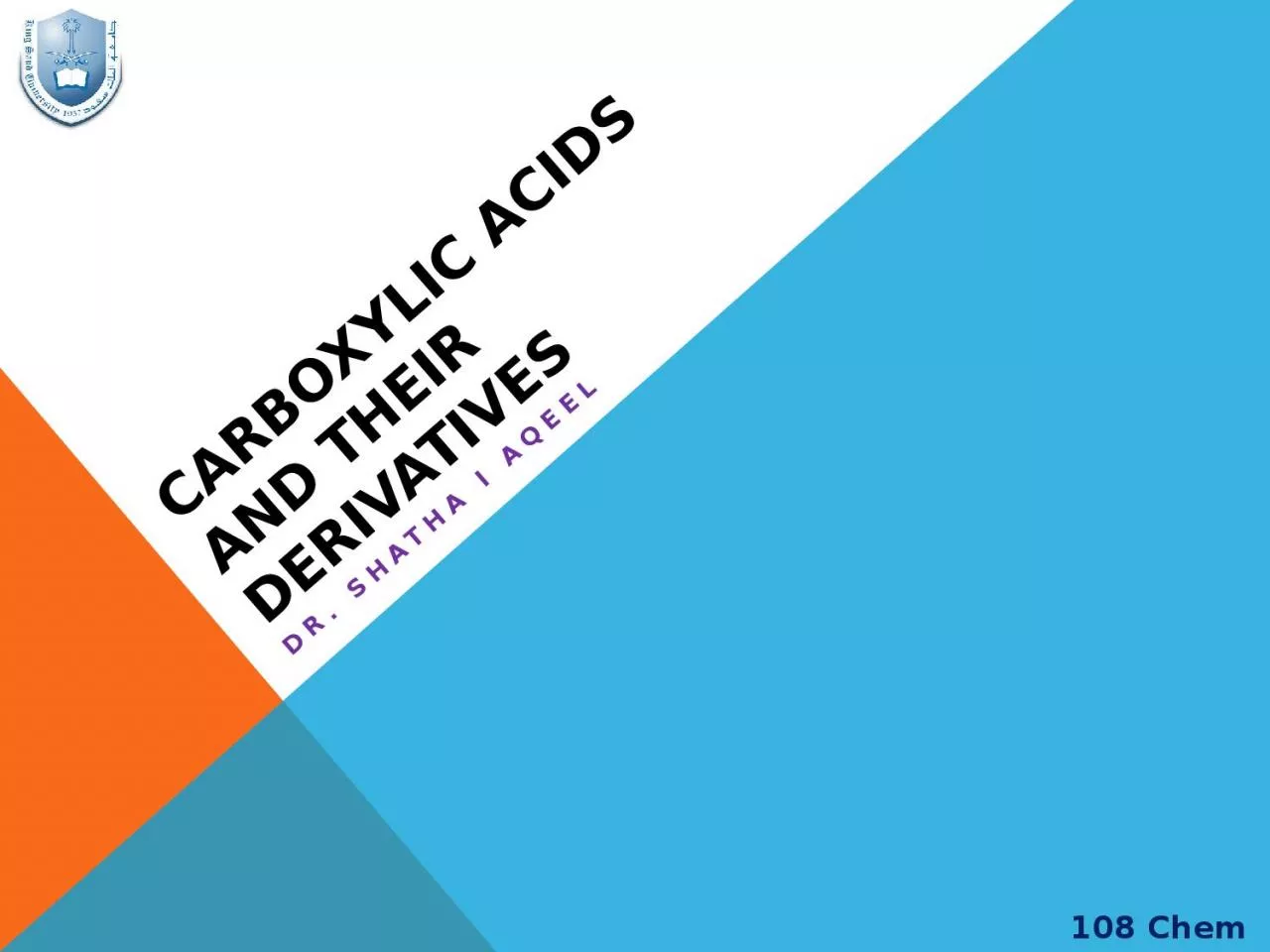

Dr SHATHA I AQEEL 108 Chem Learning Objectives Chapter nine introduces carboxylic acids and their derivatives by the end of this chapter the students will know The structure of carboxylic acids ID: 999934
Download Presentation The PPT/PDF document "Carboxylic Acids and Their Derivatives" is the property of its rightful owner. Permission is granted to download and print the materials on this web site for personal, non-commercial use only, and to display it on your personal computer provided you do not modify the materials and that you retain all copyright notices contained in the materials. By downloading content from our website, you accept the terms of this agreement.
1. Carboxylic Acids and Their DerivativesDr. SHATHA I AQEEL108 Chem
2. Learning ObjectivesChapter nine introduces carboxylic acids and their derivatives. by the end of this chapter the students will know :The structure of carboxylic acidsThe common and IUPAC nomenclature of carboxylic acidsThe physical properties of carboxylic acidsThe Factors affecting acidity of carboxylic acids.The different ways to make carboxylic acidsSalt formation reactions of carboxylic acidsThe nucleophilic substitution reactions at the carbonyl carbon and the specific products formed in each case. The chemistry of carboxylic acid derivatives2108 Chem
3. Structure Of Carboxylic AcidsCarboxylic acids are organic acids contain one or more carboxyl groupwhich is a combination of carbonyl group C=O and hydroxyl group O-HIt is often written in condensed form as –CO2H or –COOHThe general formula of a carboxylic acid is R-COOH or Ar-COOHCarboxylic acids are classified as aliphatic or aromatic depending on the Group which attached to the carboxylic group.The simplest acid is formic acid R= H3108 Chem
4. Nomenclature of Carboxylic AcidCommon Name: The common names of carboxylic acids all end in –ic acid.The names are derived from Latin or Greek and relate to their natural sources.The positions of the carbons present on the acid chain, are located by the Greek letters α indicating the carbon atom next to COOH group (C2), β (C3), etc. IUPAC Name: Find the longest continuous carbon chain contains the COOH group to get the root name of the parent hydrocarbon, then replace the ending -e by the suffix –oic acid. Number the chain starting with the carbon of COOH group as C-1Cyclic compounds containing one or more COOH groups attached to the ring are named by identifying the name of the ring followed by the word carboxylic acid.108 Chem45 4 3 2 1C—C—C—C—C=Oδ γ β α
5. 108 Chem5Carbon atomsCommon nameIUPAC nameChemical formula1Formic acidMethanoic acidHCOOH2Acetic acidEthanoic acidCH3COOH3Propionic acidPropanoic acidCH3CH2COOH4Butyric acidButanoic acidCH3(CH2)2COOH5Valeric acidPentanoic acidCH3(CH2)3COOH Cyclopropane Cyclobutane Cyclopentane Cyclohexane Carboxylic acid Carboxylic acid Carboxylic acid Carboxylic acid108 Chem
6. 108 Chem6-- Dimethyl butyric acid2,3-Dimethyl butanoic acidSuccinic acid1,4-Butandioic acid3-Ethyl-6-methyloctan1,8-dioic acid
7. 108 Chem7 Benzoic acid Phethalic acid Isophthalic acid2-Hydroxybenzenecarboxylic acidBenzene carboxylic acidBenzene-1,2-dicarboxylic acidBenzene-1,4-dicarboxylic acidBenzene-1,3-dicarboxylic acidTerephtalic acid Salicylic acido-Toluic acid2- Methyl benzene carboxylic acid
8. Carboxylic Acid DerivativesAcid Chloride Ester Amide acid anhydride1-Nomenclature of acid chloride RCOXDerived from the carboxylic acid name by Replace the -ic acid ending in the name of the parent acid by –yl chloride. Ethanoyl chloride Benzoyl chloride Acetyl chloride 108 Chem8Propanoyl chloride
9. 2- Nomenclature of estersThe alkyl group (R’) is written first followed by the name of the parent acid with replacing of the ending –ic acid by –ate : Ethyl ethanoate Methyl benzoate Ethyl acetate108 Chem9Methyl propanoate
10. 108 Chem103-Nomenclature of anhydride An anhydride is named by replacing the word acid in the corresponding acid by the word anhydride If symmetrical replace “acid” with “anhydride” based on the related carboxylic acidUnsymmetrical anhydrides— cite the two acids alphabeticallyEthanoic anhydride Benzoic anhydide Butandioic anhydride108 ChemAcetic anhydride Succinic anhydride
11. 4- Nomenclature of amideReplace the ending oic acid of the parent acid’s by the word amide With unsubstituted NH2 group , Replacing the ending oic acid of the parent acid’s by amide Ethanamide Benzamide AcetamideIf the N is further substituted, identify the substituent groups (preceded by “N”) and then the parent amide 108 Chem11 N,N-Dimethylmethanamide N-Ethyl-N-methylbenzamide N,N-Dimethylformamide
12. 108 Chem12108 ChemN,N-DiethylcyclohexancarboxylamideCyclopentanecarboxylamide
13. Physical Properties OF Carboxylic AcidsSolubilityCarboxylic acids are polar, they are capable of hydrogen bonding with water molecules.The first four aliphatic acids are completely miscible in water. Higher members are less soluble Aromatic acids are insoluble in waterboiling pointsboiling points of carboxylic acids indicate a greater degree than alcohols This is due to carboxylic acids usually exist as dimeric pairs by forming two intramolecular hydrogen bonds in nonpolar media108 Chem13
14. Acid StrengthCarboxylic acids are the most acidic simple organic compoundsalso they are more acidic than phenols & alcoholthey are weak acids compared to inorganic acids (HCl or H2SO4 because they undergo complete dissociation)Electron donating substituents decrease the acidityHCOOH > CH3COOH > CH3CH2COOH > CH3CH2CH2CH2COOH ( size of R group)Whereas Electron withdrawing substituents near the carboxyl group increase the acidity108 Chem14 Cl3CCOOH > Cl2CHCOOH > ClCH2COOH > CH3COOH ( number of e.w.g.)CH3CH2CH2CH(Cl)COOH > CH3CH2CH(Cl)CH2COOH > CH3CH(Cl)CH2CH2COOH > CH2(Cl)CH2CH2CH2COOH ( position of e.w.g. relative to COOH group
15. Preparation Of Carboxylic acids1- Oxidation Of Primary Alcohols and Aldehydes 2- Oxidation Of Alkyl Benzenes108 Chem15
16. 3- Carbonation Of Grignard Reagents4- Hydrolysis Of Nitriles 108 Chem16
17. Reactions of Carboxylic Acids1- Salts Formation108 Chem17
18. 2- Substitution of hydroxyl group108 Chem18or PCl3 or PCl5
19. Reaction of Esters108 Chem19HydrolysisAlcoholysisAmmonolysisReduction
20. Acid Chlorides: Reactions108 Chem20
21. 108 Chem21108 Chem
22. Acid anhydride: Reactions108 Chem22
23. Reactions of Amides108 Chem23
24. 108 Chem24Questions?Thank You for your kind attention !